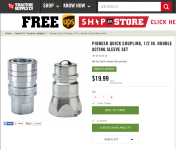Bradbilt
Silver Member
Please excuse the dumb question.
I am running hoses from my rear hydraulics up to the front of the loader to make my snow plow power angle.
Today I went to Tractor supply and bought a bunch of pioneer quick connect fittings.
I now have a "problem"....
The fitting on the back of my tractor(the female ends) I can just push the male ends in and they couple. To uncouple I just pull on the hose.
NOW, with the fittings I bought from TSC I have to pull the collar back on the female coupler to connect and disconnect them.
Is there a different coupler that I can get to just allow me to push/pull to connect/disconnect?
BTW my fittings on the rear of the tractor have a "square" pin inside the coupler, the TCS fitting have a round ball. Is that the difference?
The "tip" on this mall connector is what my tractor has in the female connector and that is the one that just push/pulls
Pioneer 1/2 in. Standard ISO Tip, 3/4 In., 16 ORB, Fits All Current Models, Poppet - For Life Out Here
The couplers I bought have this style "ball" on the male and female couplers
Pioneer Quick Coupling, 1/2 in. Single Acting Sleeve Set - For Life Out Here
I am running hoses from my rear hydraulics up to the front of the loader to make my snow plow power angle.
Today I went to Tractor supply and bought a bunch of pioneer quick connect fittings.
I now have a "problem"....
The fitting on the back of my tractor(the female ends) I can just push the male ends in and they couple. To uncouple I just pull on the hose.
NOW, with the fittings I bought from TSC I have to pull the collar back on the female coupler to connect and disconnect them.
Is there a different coupler that I can get to just allow me to push/pull to connect/disconnect?
BTW my fittings on the rear of the tractor have a "square" pin inside the coupler, the TCS fitting have a round ball. Is that the difference?
The "tip" on this mall connector is what my tractor has in the female connector and that is the one that just push/pulls
Pioneer 1/2 in. Standard ISO Tip, 3/4 In., 16 ORB, Fits All Current Models, Poppet - For Life Out Here
The couplers I bought have this style "ball" on the male and female couplers
Pioneer Quick Coupling, 1/2 in. Single Acting Sleeve Set - For Life Out Here

